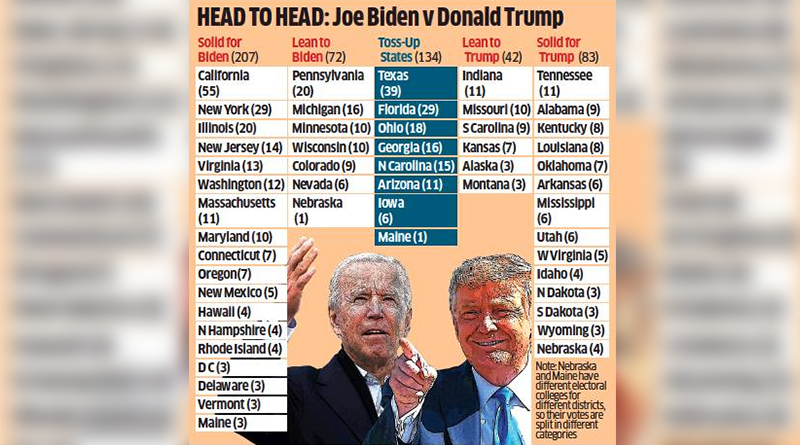In the US polls, the Democrat challenger can lose all ‘toss-up’ states and still win
Let me throw caution to the winds and declare that Joe Biden will thrash Donald Trump in the US elections on November 3. Let me not hedge my prediction with ifs and buts.
See the accompanying table, based on a Financial Times model drawing data from recent opinion polls. States where the opinion poll margin between candidates is less than 5% are defined as ‘toss-up states’. States where the margin is 5-10% are categorised as ‘leaning to’ either Biden or Trump. And states where the predicted margin exceeds 10% are categorised as ‘solid’ for either Biden or Trump.
This picture may be out of date, since new polls keep coming in every day. Do not view it as entirely accurate. But it shows a devastating trend. States with 207 electoral college votes are solidly for Biden, and states with another 72 votes are leaning towards him. This adds up to 279, above the magic figure of 270 needed for victory.
Hence, I predict a massive sweep for Biden. Going by the table, even if Trump wins every single toss-up state, collectively having 134 electoral votes, Biden will win. If the toss-up electoral college votes are split evenly, that will give Biden 346 votes to Trump’s 193, a true thrashing.
Along with the presidential election, all 435 seats in the House of Representatives and 35 of the 100 Senate seats are also being contested electorally. The trend in the table suggests a Democratic win in both the House and Senate. That will give Democrats total control of the legislative agenda, enabling major changes to ensure them more seats and votes permanently.
The US currently has 50 states. The Constitution gives seats in the House in proportion to population. But it gives two seats to every state regardless of population. This formula favours small, thinly populated states, many of which are in the Republican midwest. Hence, 30% of the US population — overwhelmingly White and not highly educated — controls 70% of the Senate seats.
The Democrats claim this is totally unfair. If they control the presidency and both Congressional Houses, they plan to confer statehood on the District of Columbia and Puerto Rico, and maybe the US Virgin Islands. All three are Democratic strongholds. This will give them a clear edge in future Senate elections.
All pollsters and pundits agree that Biden is the clear favourite. But they are wary of categorically predicting a sweep because they did that in 2016 — giving Hillary Clinton a big win over Trump — and proved dead wrong. Some pundits claimed they were not entirely wrong: Clinton actually got three millionmore popular votes than Trump. But the US president is not elected by popular vote. Instead, he or she is elected by an electoral college having delegates from each state proportionate to its population, on a winner-takes-all basis.
Trump lost by huge margins in big states like California and New York, where he did not even bother to campaign. But he won narrowly in a series of toss-up states that could have gone either way — Florida, Pennsylvania, Michigan, Wisconsin and Arizona. That clinched the electoral college for him.
Remember, even Abraham Lincoln was elected president in 1860 without a majority of votes. Indeed, his popular vote share was just 40%. But three Opposition parties split the rest of the vote in a four-cornered contest. Lincoln’s name was not even on the ballot in 10 southern states. Yet, by winning most of the northern and border states, he squeezed home. What mattered was the electoral college, and he had a majority there.
Remembering the examples of 1860 and 2016, Democrats remain tense today, despite favourable opinion polls. They know that overconfidence proved very costly in the last election. Hillary Clinton was so sure of winning traditional Democratic states like Pennsylvania, Michigan and Wisconsin that she neglected them in the final weeks of campaigning, and instead focused on states like Arizona where she thought she could oust Republican candidates in the House of Representatives. Ultimately, she lost not just the presidential election but the House and Senate elections as well. It was a humungous case of counting chickens before they hatch.
So, Democrats today warn incessantly of the dangers of overconfidence. They fear that polls showing an easy Biden victory may lower the Democratic turnout on the mistaken notion that the battle is already won. They worry about Republican tactics to try and keep Democratic supporters from voting, such as reducing the time for postal ballots, or reducing the number of early polling booths in some states to create long queues in areas favourable to the Democrats, hoping voters will stay at home fearing Covid-19 infection.
Unlike in India, each state in the US sets its own voting procedures, and can slant these one way or the other. Both parties are trading bitter accusations of rigging. The final result may be held up for weeks — even months — by lawsuits challenging the declared results. Yet, ultimately, I predict a massive Biden victory.


